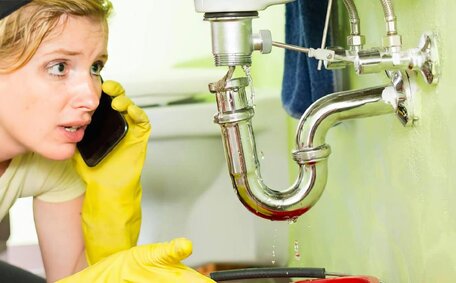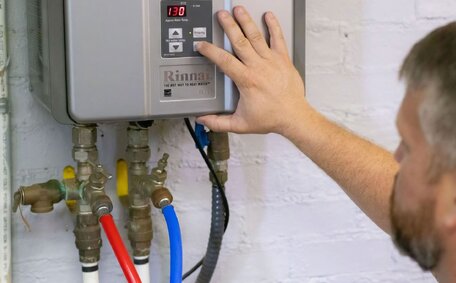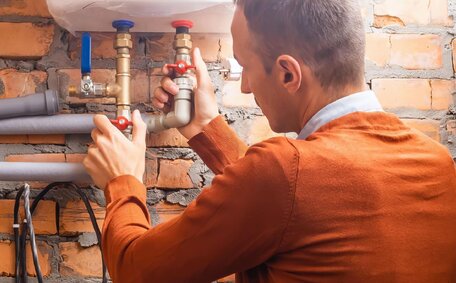How Do Direct Water Heaters Work?
Direct water heaters function by directly transferring heat energy to water as it passes through the unit. This process yields high efficiency, since no heat is lost via an intermediary heat exchanger or storage tank.
In a direct water heater, the water enters the unit and is heated by internal elements, typically powered by electricity or natural gas. As the water flows through, the unit heats water to the desired temperature before the hot water your system has heated goes directly to the taps and fixtures in your home.
As water flows directly from the heat source, direct water heaters provide domestic hot water on demand without needing to maintain a reservoir of pre-heated water. This makes them suitable for enclosed spaces without conventional water storage capabilities like remote bathrooms as there’s no need for large amounts of continuous hot water.
Benefits of Direct Water Heating
Direct water heating systems offer benefits primarily due to their lack of a storage requirement, unlike indirect systems:
- Lower Upfront Costs - Because they have no additional storage tank which simplifies design and reduces components, Direct systems typically have fewer parts, making them more affordable to purchase and install.
- Space Savings - Direct heaters feature a tankless design that occupies less space than traditional, bulkier units.
- Immediate Hot Water - Direct heaters eliminate waiting time for water to heat up, providing hot water instantly when you turn on the tap.
- Efficiency - By delivering direct heat to the water with minimal standby loss, the unit can achieve near 100% energy efficiency.
- Longevity - With fewer components that are used to heat and require less maintenance, direct units can often outlast indirect water heaters.
Limitations of Direct Water Heaters
While direct fired heaters offer efficiency and simplicity, they also come with some notable limitations:
- Higher Operating Costs - Since the unit heats water as needed, rather than maintaining a heated reserve, operational costs tend to be higher, leading to increased energy bills.
- Frequent Maintenance - The components of the heater can require more frequent checks and cleaning to keep mineral buildup at bay.
- Limited Flow Rates - Systems with a tankless coil, which is part of the coil indirect heater designs, have a determined flow rate capacity. Harnessing multiple outlets simultaneously might see a decline in heat output and delivered water temperature.
- Weather Resiliency - In extremely cold climates, the capacity of direct units may struggle to meet the heating cooling demands placed upon them.
These limitations can make direct water heaters impractical for larger households or regions with extreme weather. Carefully consider the pros cons before choosing a system, ensuring it’s right for your needs.
How Indirect Water Heaters Work
Indirect water heaters, compatible with solar water systems, operate by transferring heat from a boiler furnace or another fluid to water through a heat exchanger, rather than heating the water directly. This grants them the flexibility to be a part of central heating systems, employing various heat sources like gas oil, and solar energy capture, or warmth from your furnace boiler.
An indirect water heating system Operates in the following manner:
- A distinct heat source, such as a heat pump or electric coils utilised for ambient hot air, elevates the temperature of a medium, be it air or a glycol water composite.
- This heated fluid moves through heat exchanger with special design features that transfer heat inside the water storage tank.
- As the fluid gets used to heat, once passed through, it transfers heat to warm the water inside the tank via conduction.
- The cycle continues as the now cooler fluid is reheated, only to be cut off again by the main heat source, essentially being replaced by warm air, similar to a pump water action, and creating a closed heating loop.
- When you activate your tap, the stored water from the indirect hot water heater sends the warm air out and the tank houses water ready for use.
The benefits of indirect water heaters become evident when compared to direct systems:
- These indirect fired heaters provide a reserve water supply, strategically isolating potable water from contact open flame and combustion gases for enhanced safety.
- Significantly, the system can utilise hot water produced through renewable heat sources like solar panels.
- The indirect system’s tank ensures water is consistently heated, maintaining even pressure distribution.
Benefits of Indirect Water Heating
Indirect water heating offers some notable advantages over direct heating methods:
- Higher Efficiency - Since they maintain a tank of pre-heated water, indirect heaters typically have lower heat loss and can achieve efficiencies above 90%.
- Renewable Integration - Indirect heaters can be integrated with renewable energy sources, such as solar thermal panels, to produce eco-friendly hot water.
- Consistent Temps - Water stored in a tank provides consistent temperatures by mitigating fluctuations from intermittent use.
- Longer Lifespans - The separated heat exchanger and water tank have reduced exposure to mechanical stress and corrosion.
- Cold Weather Use - With robust tanks that store heated water, indirect heaters work well even in extremely cold climates, swiftly converting your cold water tap to hot.
With higher efficiency potential and design flexibility, indirect water heating systems shine in many home applications.
Disadvantages of Indirect Water Heaters
Despite their efficiency and design benefits, indirect water heaters have drawbacks that should be considered:
- Higher Upfront Costs - More than just the primary components, the storage tanks and heat exchangers, the installation of indirect heaters incurs higher costs compared to more basic direct system models.
- Space Requirements - Accommodating a large water storage tank in confined utility areas can be challenging.
- Complex Installation - Professional expertise is vital for proper venting to prevent carbon monoxide issues, along with installing piping, obtaining permits, and integrating with existing systems.
- Maintenance - Indirect heaters require occasional tank flushings and inspections to keep them operating efficiently.
- Standby Losses - Storing heated water allows some heat to gradually dissipate from the tank even when not in use.
Weighing these disadvantages against the perks will guide you to the best heating solutions, helping you learn more about if an indirect setup aligns with your abode’s hot water necessities and constraints.
Comparing Operating Costs
Assessing differences and unique cost implications between direct and indirect water heating systems is essential when considering operating expenses. Indirect systems often have lower operational costs due to higher efficiency, while direct heating may cost less depending on utility rates.
On average, indirect water heaters, by avoiding direct contact with heating elements, are more energy efficient, converting 90-95% of their fuel into usable heat. This is due to maintaining a thermal reservoir instead of heating water on demand. Standby heat losses from storage tanks are usually minor compared to the efficiency gains.
However, direct systems achieve nearly 100% efficiency as all energy put in converts directly to heated water output. If electricity costs are high in your region, maintaining an electric indirect heater could surpass the expense of direct heating.
Using natural gas, tankless water heaters, especially indirect models, offer an efficient and cost-effective way to provide ample hot water due to their high efficiency. However, if your household requires large volumes of hot water, the energy usage of a direct heating system may lead to higher costs compared to indirect systems.
To ascertain the most cost-effective type of heater over time, factor in local energy prices per therm or kWh, average household hot water usage, and heater efficiency ratings. This life cycle cost analysis indicates the difference between direct or indirect water heating in terms of alignment with your budget.
Matching a System to Your Needs
Choosing a hot water heating system requires consideration of your household’s unique needs to ensure you select the most suitable option.
Key factors to weigh up include:
- Available Space - Tankless water systems need less area for installation than indirect heaters with storage tanks. It is recommended to measure your utility spaces in advance.
- Hot Water Demand - Indirect water heaters, particularly those with large tanks and solar heating features, can meet high hot water demand more effectively than direct systems.
- Water Quality - Hard water necessitates regular flushings and maintenance. Using water softeners helps extend indirect tank lifespans.
- Energy Prices - If electricity costs are high, opting for indirect with gas or solar energy may save on hot water costs for your home in the long-term.
- Climate - In cold regions, indirect heaters can run space heating, handling higher heating loads more reliably.
Ashfield Plumbing, with ten years of experience in hot water system installation throughout Sydney, provides customised advice for your home. Contact us on 1300 349 338 or email to discuss your needs.






